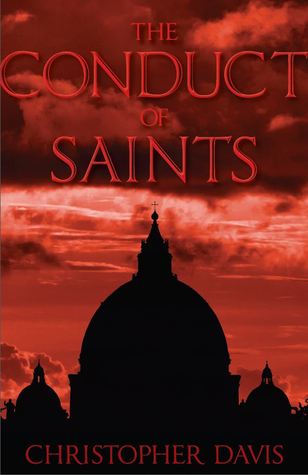Dark Historical Novel Lacks Pathos

Although the title of his psychologically and structurally intricate 12th novel The Conduct of Saints suggests an exploration of the beatified, the conduct that most interests Christopher Davis is that of so-called ordinary ecclesiastical characters, among them Pope Pius XII (d. 1968) and particularly the heavy-drinking Irish-American priest Brendan Doherty, at the center of this historical story.
Set in Rome, during the two months before the end of World War II, Davis’s carefully researched narrative, which includes real-life personages, focuses on May 1945 but also looks back to 1943 when the Nazi juggernaut descended on the Holy See, and, by way of constantly shifting points of view, also to the earlier lives of the book’s cast of diverse characters. With just a couple of exceptions, their venal, corrupt, perverse, if not evil, behavior could be said to constitute an indictment of fascist Italy, were the implied theme of The Conduct of Saints not darker and more pervasive—man’s eternal inhumanity to man.
The Conduct of Saints keeps its distance, letting the degeneracy of the war and post-war period rule, as though this were a documentary, which is its strength. People were, and are, like that, especially in desperate times. But for all its subtlety and historical significance, the novel is curiously unmoving. It has not one character to care about. Brendan, with his conscience, sense of guilt and brutal honesty comes close, but because of Davis’s warts-and-all descriptions, doesn’t engage.
The novel does revive the still-debated issue of the pope’s politics and actions regarding Italy’s Jews who were brutally torn from their homes and sent to ghettos and camps, but it subsumes those horrific events into a wider context—scenes of debauched sex, aristocratic decadence, street poverty, church interiors empty of soul. Corruption is everywhere; no one is spared, including the Allied liberators.
If The Conduct of Saints seems more cinematic than novelistic, that may be due to its alternating perspectives and settings, with minor characters becoming important for a while but not claiming sustained attention. The wealthy live on with the remains of their bargaining chips (fake or dubiously acquired art), bed each other, gender notwithstanding. A few support resistance efforts or the communist insurgency but to no great avail. Brendan, a lawyer, moves among them, seeking assistance in his twin quests. One is as devil’s advocate to ferret out the truth from (real-life) Alesandro Serenelli, who 43 years earlier raped and stabbed to death (14 times) a young girl, Maria Goretti. She is now a candidate for canonization, and the church would like Serenelli’s testimony about his religious conversion, which includes visions of Maria, to count on her behalf. Brendan thinks Serenelli is a sham.
Indeed, he thinks just about everyone is a liar or manipulator, including himself. His other quest is more difficult—to get the Italian courts to reduce the death sentence of a mass murderer, an Italian-born Nazi, because to Brendan capital punishment is only doing to others what they have done. Meanwhile, the (real-life) Luchino Visconti gets permission to film the execution.
Davis’s style can be convoluted, arcane, full of qualifications, sometimes with words that impart a quaint formality: “The soutane is rucked up.” Names are used sometimes in full, sometimes with just the first or just the last in the same paragraph. Many sentences have to be read slowly: After 12-year-old Brendan is with a boy in the next apartment, they go outside, “adjusting their clothing, they were silent, shy, God’s power less than a match-flame in the sun. But what had returned with Michael’s fleeting resurrection [memory] was the memory of the joy of shouted certainties.”
Even if one invokes Yeats’ line for the book that “the centre cannot hold,” an enthusiastic admirer might well shoot back, of course, that’s Davis’s point: La Cinico Vita. The Conduct of Saints is assuredly a complex, intelligent and historically significant novel and an important publication from Sag Harbor’s independent publishers, The Permanent Press but, alas, for me, not compelling.



